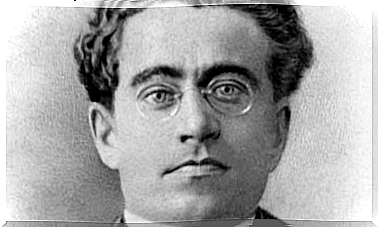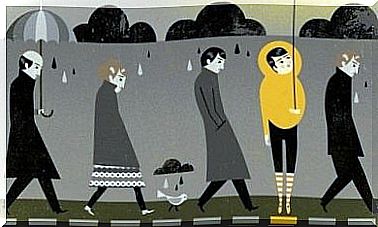The Story Behind The Psychology Symbol (Ψ)
The story behind the psychology symbol involves some mythology and the strange evolution of the term ‘psi’ (Ψ). It is the twenty-third letter in the Greek alphabet, and at one point the Romans transliterated it to form the word psyche. It meant butterfly in Latin, but later it came to mean things like wind, breath, energy and eventually soul.
Anyone who has studied psychology will remember that this strange symbol popped up almost everywhere during their studies. Books, professors’ offices, informative notes… Anyone curious about this branch of science will recognize it too, as it has become part of a culture of symbols that is also found in many other disciplines, such as philosophy and ‘phi’ ( ).
Yet there are times when we just take these symbols for granted and don’t think much about them. It’s also true that many of us believe in monkey stories that twist the magic of our roots. In this sense, it is common to hear people say that the psychology symbol (Ψ) is a trident. More specifically, they say it’s the devil’s trident.
This erroneous theory has its origins in the times when people saw mental illness as demonic possession. Mental disorders had supernatural origins such as spells and witchcraft, things beyond human control. That meant everything was in the hands of the church and, of course, the pyre. But nothing could be further from the truth. So let’s look at the true origin of the psychology symbol.
The history of the psychology symbol (Ψ), the science of the soul
In ancient Greek, the word psyche (as we said earlier) meant butterfly. This insect was also a symbol for the breath of life, a breeze, a life-giving wind… Gradually , thanks to the influence of the Roman Empire, the word began to symbolize the human soul. What they saw was our life force, also known as ‘ka’ in Egyptian culture.
The Greeks and Romans had a very specific view of the soul when it came to humans. One of their beliefs was that when someone died, the ‘ka’ that the Egyptians spoke of would leave their body in the form of a breath of air. This puff of air would take the shape of a butterfly. There was nothing terrifying about that image in their minds, either. For them, butterflies represented light, change and hope.
The history of the psychology symbol has adopted that term, psyche. Later it would become ‘logia’ (ψυχή and λογία). This is how its etymological meaning moved over time from ‘the science of the soul’ to ‘the science of the mind’. Naturally, the symbol ‘Ψ’ was used as the primary symbol, such as an abbreviation.
The Myth of Eros (Cupid) and Psyche
In Greek mythology, the word “psyche” means more than just butterfly, soul, and spirit. Psyche was also a goddess, a beautiful creature with butterfly wings. Her love story is one of the most beautiful love stories of all time and it was immortalized by Apuleius in Metamorphoses (The Golden Ass).
According to the story, one of the three daughters of the king of Anatolia was a very special girl. She was so delicate, attractive and full of joy that Aphrodite herself became jealous of her and saw this young woman as a rival. She was so desperately jealous that she immediately sent her son Eros (Cupid) to shoot her with his arrows. Her wish was that young Psyche would fall for the most terrible, ugly and heartless man in all of Anatolia.
But nothing went according to plan. Instead, it was her son, Eros, who fell for Psyche. Unable to stop herself, the young god decided to go to her room every night to win her over and make her his own. And so it happened. Psyche fell head over heels for a stranger who visited her every night in the dark. She couldn’t even see his face. The stranger was a god who wanted to keep his identity a secret.
But something went wrong. When Psyche told her sisters about her secret admirer, they told her not to continue the relationship if she was not allowed to see the face of her mysterious lover. So that’s what she did. While Eros was sleeping in her bed, she held a lamp next to his face. At that moment, Aphrodite’s son awoke and stormed out, absolutely furious at Psyche’s brutality.
The Trials of Psyche
Inconsolable, dejected and full of regret, the daughter of the king of Anatolia went to Aphrodite to ask her for help. Eros’ mother saw this as an opportunity to gain the upper hand. She saw it as her chance to rid the world of this woman who even rivaled the goddess of beauty herself. She gave her four trials, four tasks to complete if she wanted Eros to love and forgive her again. These trials, however, entailed traveling to the underworld, facing Cerberus himself, traveling with Charon, and later with Hades, to reach Persephone and ask her for some of her beauty, which she in a small box kept.
Against all odds , however , Psyche showed that she was not just beautiful. She was also smart, brave and determined. But just as she successfully completed each challenge and got hold of Persephone’s box, she experienced a moment of vanity and curiosity. She decided to open the box to see what was inside and took some of the beauty for herself. That’s when she fell prey to the trap: Stilius’ dream. Fortunately, a familiar hand pulled the cursed box away from her nose. The familiar skin of the hand comforted her, and the owner’s hopeful face immediately brought back her joy. It was Eros who had now forgiven her and came to her aid.
The story of this magical couple could not have had a happier ending. Aphrodite ceased to be jealous of her son’s beloved and danced with them at their wedding. Zeus decided to make Psyche immortal. Now that brave, beautiful woman with butterfly wings also represents the psychology symbol ‘Ψ’.









